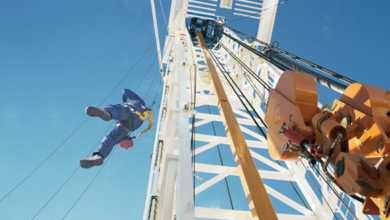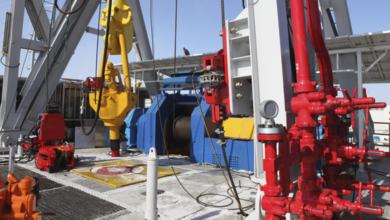Drilling Ahead: Shale revolution shifts to oily & international phase
By Mike Killalea, editor & publisher
The shale revolution has shifted into a new phase to encompass oil plays and expand its frontiers beyond North America. In today’s US rig count, the increase in oil-focused rigs mirrors nearly perfectly the decline in gas rigs.
Nonetheless, gas production has not fallen along with the rig count. Conversely, production continues to rise, according to bentekenergy.com. This belies naysayers about the long-term sustainability of shale gas. Skeptics have further protested that multi-stage fracing of horizontal wells is too costly, too difficult to implement on large scale, too risky to the environment and that decline curves from shale gas are too steep.
“So far, these skeptics have been wrong,” noted Alfred Holcomb, Lewis Energy Group, speaking at IADC World Drilling 2011, held during June in Copenhagen.
Daily production of natural gas in the Barnett Shale alone has doubled over the past four years, despite a 60% decline in the rig count. Like stories exist for the Fayetteville and Barnett.
Environmental threats are overblown. A new report by the UK Parliament found no risk to aquifers from hydraulic fracturing, given proper well construction. But technology is mitigating purported environmental issues anyway. Halliburton has developed fluids from products used in the food industry – edible, in other words – as well as improved bacteria control, better recycling of produced water, and coagulation of suspended matter.
www.energyindepth.org is an excellent information source on shales. IADC is a founding member.
As the shale chase moves outside North America, Mr Holcomb predicts dramatic realignment of people and capital. But, “duplicating the North American story won’t be easy globally, because shale lean gas requires the right rocks, infrastructure, services and favorable prices.”
These realignments are already in play. Shell and China National Petroleum Co in June formed an alliance that includes developing a highly automated Well Manufacturing System to commercialize tight gas, shale gas and coalbed methane (read more here). In April, Italian rig manufacturer Drillmec announced the sale to Chinese drilling firm Greka Drilling of 25 hydraulic rigs, with an option for an additional 125 rigs. The units will work CBM and shale gas in China’s Shanxi Province.
Then there’s Europe. In Poland alone, Western and Polish operators have snapped up more than 50 concessions, according to Wieslaw Prugar, president/CEO of Polish producer ORLEN Upstream, speaking at World Drilling.
“This industry in Poland is 160 years old,” Mr Prugar said, “and we’ve never thought more than 140 billion cubic meters of recoverable reserves, and now we’re talking 5.3 trillion.”
Equipment availability is a major bottleneck. In Poland, only five of its 15 land rigs can drill deep shale gas. Mr Prugar estimated that 20-25 rigs may be required soon, and perhaps 50 more beyond 2020 (read more here).
Ditto for fracing equipment. North America has 25% of worldwide shale reserves, but an overwhelming 75% of pressure-pumping equipment, explained Mark Van Domelen, senior technical advisor, Halliburton Energy Services, who also spoke at IADC World Drilling.
The real game changer may well be oil plays developed with multi-stage fracing of horizontal wells, both in North America and elsewhere, Mr Holcomb notes. Trends certainly underscore this. Spears and Associates predict 15,000 new horizontal wells in 2011, up from 12,500 last year. Some observers forecast 1,100 US rigs drilling horizontal wells by year-end.
The best news about shale oils is that these plays may be economical at $60 oil. In an industry noted for volatility, such a low price threshold sounds a lot like that elusive condition – stability.
Mike Killalea can be reached via e-mail at mike.killalea@iadc.org.



